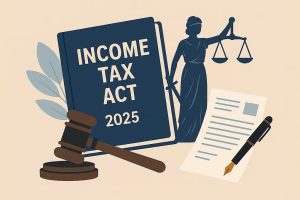Table of Contents
ToggleIntroduction
When it comes to Income Tax Filing for A.Y.2025-26, most taxpayers face a common question: Which ITR form should I file? The Income Tax Department has rolled out updated ITR forms for FY 2024-25, aligning with changes announced in Budget 2024. Whether you are a salaried individual, a small business owner, a professional, or someone earning capital gains, selecting the correct ITR form is essential.
Think of it like choosing the right tool for a job. You wouldn’t use a hammer to cut wood. Similarly, filing the wrong ITR form could lead to rejection, penalties, or unnecessary hassles. This article will simplify the complex rules in plain English and guide you step by step on which form—ITR-1, ITR-2, ITR-3, or ITR-4—applies to you.
Table of Contents
| Sr# | Headings |
| 1 | Understanding Income Tax Filing for A.Y.2025-26 |
| 2 | What’s New in ITR Filing for FY 2024-25? |
| 3 | Who Should Use ITR-1 (Sahaj)? |
| 4 | Eligibility Conditions for ITR-1 |
| 5 | Who Should Use ITR-2? |
| 6 | Eligibility Conditions for ITR-2 |
| 7 | Who Should Use ITR-3? |
| 8 | Eligibility Conditions for ITR-3 |
| 9 | Who Should Use ITR-4 (Sugam)? |
| 10 | Eligibility Conditions for ITR-4 |
| 11 | Other ITR Forms: ITR-5, ITR-6, and ITR-7 |
| 12 | Mandatory ITR Filing Even Below Exemption Limit |
| 13 | Last Date for ITR Filing for FY 2024-25 (AY 2025-26) |
| 14 | Common Mistakes to Avoid During ITR Filing |
| 15 | Final Thoughts on Choosing the Right ITR Form |
1. Understanding Income Tax Filing for A.Y.2025-26
Before diving into forms, let’s clear the basics. Income Tax Filing for A.Y.2025-26 means you are reporting your earnings from April 1, 2024, to March 31, 2025, to the government. Based on your income type—salary, business, capital gains, or foreign assets—you need to file a specific ITR form.
Just like different train tickets apply for sleeper class and AC class, ITR forms vary depending on your income source.
2. What’s New in ITR Filing for FY 2024-25?
The government has updated ITR forms to match the Budget 2024 announcements. Some key highlights include:
- ITR-1 now allows reporting long-term capital gains up to ₹1.25 lakh from listed equity and mutual funds.
- ITR-2 now requires classification of capital gains as pre-July 23, 2024, and post-July 23, 2024.
- Asset and liability reporting limit has increased from ₹50 lakh to ₹1 crore.
- ITR-3 now includes references to Section 44BBC (Cruise business).
- ITR-4 presumptive taxation limits are revised for professionals and businesses if 95% receipts are digital.
3. Who Should Use ITR-1 (Sahaj)?
The ITR-1 form is the simplest. It applies mainly to resident individuals with straightforward income.
4. Eligibility Conditions for ITR-1
You can file ITR-1 if:
- You are an individual (Resident and Ordinarily Resident).
- Your total taxable income is up to ₹50 lakh.
- Your income includes salary, pension, one house property, and other sources such as bank interest.
- You earn long-term capital gains up to ₹1.25 lakh from listed equity shares or mutual funds.
- You have agricultural income up to ₹5,000.
However, if you are a director in a company, own unlisted shares, or earn income abroad, you cannot use ITR-1.
5. Who Should Use ITR-2?
When income becomes more complex, ITR-2 comes into play. Salaried individuals with multiple house properties, foreign assets, or higher capital gains fall under this category.
6. Eligibility Conditions for ITR-2
You should file ITR-2 if:
- Your income exceeds ₹50 lakh.
- You earn from multiple house properties.
- You earn capital gains beyond ₹1.25 lakh.
- You are a director in a company.
- You own unlisted shares.
- You earn income outside India or own foreign assets.
- You earn from Virtual Digital Assets (cryptocurrency, NFTs, etc.).
- You are an RNOR (Resident but Not Ordinarily Resident) or a Non-Resident.
7. Who Should Use ITR-3?
If you run a business or practice a profession, ITR-3 is for you.
8. Eligibility Conditions for ITR-3
File ITR-3 if you:
- Earn income from a business or profession.
- Are a partner in a firm.
- Earn profits or losses from Futures & Options or intra-day stock trading.
9. Who Should Use ITR-4 (Sugam)?
ITR-4 is designed for small taxpayers who opt for presumptive taxation under Sections 44AD, 44ADA, and 44AE.
10. Eligibility Conditions for ITR-4
You can use ITR-4 if:
- You are a Resident Individual, HUF, or Firm (other than LLP).
- Your total income is up to ₹50 lakh.
- You opt for presumptive taxation under Sections 44AD, 44ADA, or 44AE.
- Professionals can use ITR-4 if their receipts are up to ₹75 lakh, provided 95% is digital.
- Businesses can use ITR-4 if turnover is up to ₹2 crore (₹3 crore with 95% digital receipts).
11. Other ITR Forms: ITR-5, ITR-6, and ITR-7
- ITR-5: For firms, LLPs, and associations.
- ITR-6: For companies (except those filing under ITR-7).
- ITR-7: For charitable trusts, political parties, religious institutions, and research bodies.
12. Mandatory ITR Filing Even Below Exemption Limit
Even if your income is below the basic exemption limit, you must file ITR if:
- You spend more than ₹2 lakh on foreign travel.
- You pay electricity bills above ₹1 lakh.
- You deposit ₹1 crore or more in a current account.
- You hold foreign assets or signatory rights abroad.
- Your TDS/TCS is ₹25,000 or more (₹50,000 for seniors).
- You want to claim refunds or exemptions.
13. Last Date for ITR Filing for FY 2024-25 (AY 2025-26)
The last date for salaried taxpayers and HUFs is September 15, 2025. For businesses requiring audits, the due date is October 31, 2025. If international transactions are involved, the deadline extends to November 30, 2025.
14. Common Mistakes to Avoid During ITR Filing
- Choosing the wrong ITR form.
- Forgetting to report interest income.
- Ignoring capital gains from mutual funds.
- Missing the deadline.
- Not reconciling Form 26AS and AIS with your ITR.
15. Final Thoughts on Choosing the Right ITR Form
Selecting the correct ITR form is like picking the right key for a lock. If you choose wisely, filing becomes smooth and stress-free. With updated rules, Income Tax Filing for A.Y.2025-26 requires careful attention. Whether you fall under ITR-1, ITR-2, ITR-3, or ITR-4, ensure compliance and accuracy to avoid penalties.
FAQs
- Can I file ITR-1 if I earn capital gains?
Yes, but only if the gains are from listed equity or mutual funds and up to ₹1.25 lakh. - Do I need to file ITR if my income is below ₹2.5 lakh?
Yes, if you meet specific conditions like high electricity bills, foreign travel, or large deposits. - Which ITR form should professionals like doctors and lawyers file?
They can file ITR-4 under presumptive taxation (up to ₹75 lakh digital receipts) or ITR-3 if above that. - What happens if I file the wrong ITR form?
Your return may be rejected, leading to penalties or refiling. - What is the deadline for Income Tax Filing for A.Y.2025-26?
For most individuals, it’s September 15, 2025. For audit cases, it’s October 31 or November 30, 2025.




